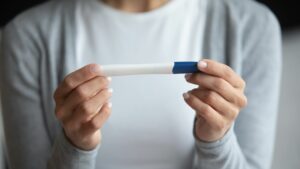Oncologists are working closely with reproductive endocrinologists to provide options for fertility preservation.
Being diagnosed with cancer can be frightening and will bring up a variety of what ifs. One of those questions is “Will I be able to have children in the future?”
This question seems to be one of increasing importance among young people diagnosed with cancer.
Chemotherapy’s effects
The choice of which medication you will receive greatly depends upon physician preference and the type of cancer needing to be treated. Some common classes of chemo drugs and how they may affect your fertility are described below:
- Alkylating agent: Ovarian scarring and depletion of eggs.
- Cisplatin and analogues: Causes lethal mutations of DNA contained in the egg/sperm. These mutations can cause a variety of defects within the growing fetus or cause a spontaneous abortion.
- Vinca alkaloids: Causes changes in DNA of the egg/sperm which may result in malformed fetuses.
- Antimetabolites: Stops DNA and RNA production in active cells which will prevent the necessary maturation of the egg/sperm.
- Topoisomerase: Causes lethal mutations in egg/sperm.
- Taxols: Blocks migration of the sperm and egg nuclei in fertilized eggs.
Radiotherapy
Radiation therapy poses a new set of challenges for the continuously cycling gametes. The effects of standard treatment dosing can cause malformations of the fetus or spontaneous abortions.
The Options
The best approach to fertility preservation depends on the type of cancer, type of treatment the patient is receiving, time until therapy begins, patients’ age and whether the patient has a partner. Several options are listed below. Talk with your doctors about the pros/cons of each of these methods.
- Gonadal shielding: Lead lined drapes, or shields, are placed upon the body in front of the reproductive organs in order to reduce the dose of radiation delivered to these areas.
- Cryopreservation of embryo: After stimulation of the ovaries and induction of ovulation, the eggs are removed, fertilized, and frozen for use later.
- Cryopreservation of the oocyte: This is almost the same as preservation of the embryos except the eggs are not fertilized; instead they are removed and directly frozen.
- Ovarian/testicular suppression: Medication will be used to make the ovary/testicle become dormant or not active. This, in essence, will prevent the cyclical maturing of eggs and ovulation as well as stop sperm formation.
- Ovarian transposition: Used in radiotherapy. The ovaries are moved out of the area that will be exposed. This does not prevent radiation exposure but minimizes it.
- Ovarian/testicular tissue cryopreservation: Ovarian/testicular tissue is removed, preserved and can be transplanted back when treatment of the cancer is completed.
- Donor eggs: This is a great option for women who cannot postpone cancer therapy, who do not want to undergo experimental techniques, or their type of malignancy inhibits ovarian tissue transfer. When the patient is in remission and is ready for pregnancy, the donor egg undergoes IVF with the patient partner’s sperm or donor sperm of her choosing.
- Sperm cryopreservation: Sperm, either obtained through masturbation or by alternative means, are frozen before therapy is started and are available to use when the patient sees fit.
- Apoptotic inhibitors: Medications can be used to inhibit apoptosis (programmed cell death). This, in theory, will inhibit the destruction of oocytes from apoptosis which would normally leave the patient with premature ovarian failure. This is a newer technique and more research is needed.
Success Rates
| Technique | Pregnancy rate | Live birth rate |
| Oocyte cryopreservation | 35-65% | ~5% per oocyte transferred |
| Embryo cryopreservation | ~37% (vs 34% fresh IVF) | 33% |
| Ovarian tissue cryopreservation | Limited data | 17 births world wide |
| Ovarian transposition | 32% (limited data) | Limited data |
| Donor oocytes | 39% | 33.8% (vs 55.1% fresh) |
| Donor sperm | 50-80% | |
| Sperm cryopreservation | Very high (masturbation) 30-70% (extraction) | |
| Testicular tissue cryopreservation | No available human success rates yet |
Here is a patient education video about fertility preservation after a cancer diagnosis.
Obviously, a cancer diagnosis is not what anyone wants to hear. Fortunately, fertility preservation is possible for many patients.
If you would like information about our fertility preservation program, as a low cost fertility center, please contact us here.






